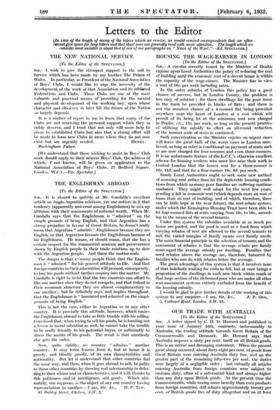HOUSING THE WAGE-EARNER IN LONDON
[To the Editor of the Srac-rs.ron.]
circular recently issued by the Minister of Health enjoins upon Local Authorities the policy of reducing the cost of building until the economic rent of a decent house is withizt the capacity of the wage-earner. The Minister has in view -a rent of 10s. per week including rates.
In the outer suburbs of London this i,olicy has a good chance of success, but in London County, the problem is less easy of solution ; for there dwellings for the poor Must in the main be provided in blocks of flats; and there is not the remotest chance of a 4-roomed flat being provided anywhere near the heart of London at a cost which will permit of its being let at the minimum rent now charged in Poplar, riz., 15s. per week, so long as the present practice of utilizing the subsidy to effect an all-round reduction of the normal scale of rents is continued.'
Such concentration as the Minister enjoins on urgent eases will leave the great bulk of the worst cases in London unre- lieved, so long as relief is conditional on payment of rents such as are now charged for four-roomers and even three-roomers. It is an unfortunate feature of -the L.C.C.'s otherwise excellent scheme for housing workers who must live near their work in Central London that the lowest rent for a three-roomer is 16s. 11d, and that for a four-roomer 19s. 8d. per week.
Surely Local Authorities ought to seek some new method of assessing rent rather than let the deplorable housing condi- tions from which so many poor families are suffering continue unabated. They might well adopt for the next few years, pending a fall in economic rent (which depends more on cost of loans than on cost of building, and of which, therefore, there can be little hope in the near future), the rent-rebate system, under which the Kensington Housing Trust have been able to let four-roomed flats at rents varying from 105. to 18s., accord- ing to the means of the several tenants.
Under this system the subsidies available at so much per house are pooled, and the pool is used as a fund from which varying rebates of rent are allowed to the several tenants to suit the varied margins of family means over family needs. The main financial principle in the selection of tenants and the assessment of rebates is that the average rebate per family must equal the average subsidy per dwelling. Families that need rebates above the average are, therefore, balanced, by families who can do with rebates below the. average.
The great advantage of this system is that it involves none of that indefinite waiting for costs to fall, but at once brings a proportion of the dwellings in each new block within reach of that large section of the ill-housed poor who arc under all other rent-assessment systems entirely excluded from the benefit of the housing subsidy, I would be glad to give further_ details of the working of this








































 Previous page
Previous page